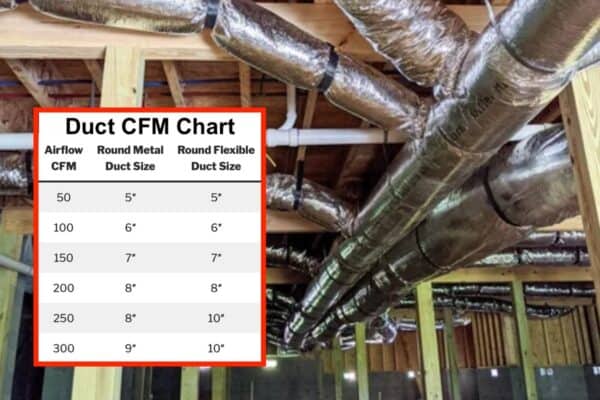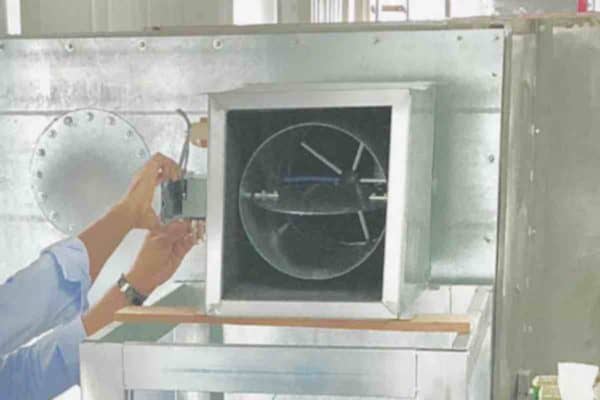Duct Friction Loss Formula: How to Calculate Friction Loss in Ducts?
As an engineer, we are taught to size ducts based on a common friction loss value using tools such as the friction loss chart and duct sizer software. I’ve been wondering about the underlying formulas that these tools used to calculate friction loss in ducts. So, I did some research.
It turns out that the friction loss chart provided by ASHRAE is based on the Darcy and Colebrook equations. The first equation is used to calculate the friction factor which involved the use of Reynolds number and the second equation rely on the first equation to find the resulting friction loss for a given duct diameter and air velocity.
The equations look simple at first but when I dive deeper into the calculations, I sort of realize why nobody uses the raw equations to calculate duct size. However, I also find some good alternatives to make the equations work as a duct sizer.
Duct Friction Loss Equation
The Darcy and Colebrook equations used to calculate the friction loss in ducts is well documented in the ASHRAE Handbook of Fundamentals. However, you need to spend quite some time understanding the raw formulas. So, I’ll break it down for you here.
The Darcy Equation
For fluid flow in conduits, for instance, air flowing inside an air conditioning duct, friction loss can be calculated by the Darcy equation as follows:
Δpf = (12fL/D)(ρ)(V/1097)2
where,
Δpf = duct friction loss, in.wg
f = friction factor
L = duct length, ft
D = duct diameter, in
ρ = density of air, lb/ft3
V = air velocity, fpm
From the Darcy equation, Δpf or friction loss is the one that we want to calculate. Normally, we use this value to find the duct size (eg.: 0.1 in.wg/100ft). But, with this equation, we have to do it the opposite way. Later, you’ll see why.
Next, we talk about the easy ones first. L is the duct length. The friction loss we’re trying to calculate is more commonly expressed as how many inch of water per 100 feet. Hence, the duct length we can straight away put 100 ft so that the friction loss outcome from this equation is in.wg/100ft.
D or Dh as written in the ASHRAE Handbook is the duct diameter (ASHRAE calls it hydraulic diameter). The reason why it is call hydraulic diameter and not just diameter (I think) is because ASHRAE wanted to use a single term for both round and rectangular ducts. I find duct diameter is easier to understand and you’ll see why later in this post.
After the duct diameter is the density of air which the “standard” value used in the friction loss chart is 0.75 lb/ft3 as clarified by ASHRAE. And, the last input we need for the Darcy equation is the air velocity inside the duct. This requires us to consider for noise control which I’ll touch on it later.
Now, the hard part. f is the friction factor and it needs an entirely new equation to calculate. The equation to find the friction factor is the Colebrook’s equation. Hence, the name Darcy and Colebrook equations.
Colebrook’s Equation
The friction factor used to calculate duct friction loss depends on duct surface roughness which depends on the duct type/material, and internal protuberances (duct connection/joint type). With that, the friction factor f can be calculated by Colebrook’s equation as follows:
1/√f = -2 log [ (12ɛ/3.7D) + (2.51/Re√f) ]
where,
f = friction factor
ɛ = material absolute roughness, ft
D = duct diameter, in
Re = Reynolds number
Now, Colebrook’s equation cannot be solved explicitly for f. Instead, we need to use iterative techniques to determine the friction factor which basically means we need to keep guessing the f number until both sides of the equation match.
Colebrook’s equation is considered the most accurate for friction factor calculation. However, with an acceptable margin of error, I find other alternative equations which don’t require guessing the number can work as well.
There are two alternative equations to solve explicitly for f; the Swamee-Jain equation and the Haaland equation. Through my limited tests, I find that the Haaland equation is closer to Colebrook’s equation. In fact, a comprehensive report shows the error is only around 1.4%.
Solve Explicitly for f – The Haaland Equation
The best thing about the Haaland equation is we can use an excel sheet to calculate. With Colebrook’s equation, we need to keep trying to find the right f value. Anyway, the friction factor f can be calculated using the Haaland equation as follows:
1/√f = -1.8 log [ (3.243ɛ/D)1.11 + (6.9/Re) ]
where,
f = friction factor
ɛ = material absolute roughness, ft
D = duct diameter, in
Re = Reynolds number
Notice that the equation is similar but the right hand side no longer has f. So, we can directly calculate the friction factor from this equation.
A new input required for this equation is ɛ or the absolute roughness of the duct material. The most common value for ɛ is 0.0003 ft for galvanized steel ducts (round & rectangular) and 0.003 ft for flexible ducts. However, I found that certain duct sizer software use 0.0005 ft for galvanized ducts.
ASHRAE explained in their Handbook that the change from 0.0003 ft to 0.0005 ft is primarily due to 2.5 ft joint spacing. Apparently, if the joint spacing increases, the absolute roughness decreases.
Reynolds Number
Re or Reynolds number shows if the air within the duct is laminar flow or turbulent flow. Re is based on duct diameter, air velocity and viscosity. According to ASHRAE, for standard air and temperature between 40 and 100°F, Re can be calculated as follows:
Re = 8.5DV
where,
Re = Reynolds number
D = duct diameter, in
V = air velocity, fpm
With the above three equations, we can now calculate the friction loss in ducts.
Duct Friction Loss Calculation Example
Given that we have a fan coil unit that pumps out 800 cfm of airflow. Our target friction loss is not more than 0.1 in.wg/100ft. The duct type/material is rigid galvanized steel round duct. So, the material absolute roughness or ɛ is 0.0005 ft. Now, we want to find the suitable duct size that does not lead to high velocity for noise control.
So, we start by fixing the air velocity at 900 fpm which is the maximum value recommended by ACCA’s Manual D for residential supply air duct. Next, we try an arbitrary duct size of 14 inches to see what is the resulting friction loss and airflow.
First of all, at 900 fpm, a 14 inches duct will deliver 962 cfm of airflow. This can be calculated by a simple formula as follows:
Q = AV
where,
Q = airflow, cfm
A = duct area, ft2
V = air velocity, fpm
Now the basic formula to calculate duct area from duct diameter is:
A = πr2
where,
A = duct area, ft2
π = 3.142
r = duct radius (D/2), ft
So,
A = πr2
A = 3.142 x (14/12/2)2
A = 1.069 ft2
Therefore,
Q = AV
Q = 1.069 x 900
Q = 962 cfm
Now, the airflow of the FCU is actually 800 cfm. Thus,
V = Q/A
V = 800/1.069
V = 748 fpm
By knowing the velocity, we can calculate the Reynolds number.
Re = 8.5DV
Re = 8.5 x 14 x 748
Re = 89,012
From there, insert the known parameters into the Haaland equation to find the friction factor.
1/√f = -1.8 log [ (3.243ɛ/D)1.11 + (6.9/Re) ]
1/√f = -1.8 log [ (3.243*0.0005/14)1.11 + (6.9/89012) ]
1/√f = -1.8 log (1.203 x 10-4 )
1/√f = 7.055
f = (1/7.055)2
f = 0.02009
Finally, use the Darcy equation to find the duct friction loss per 100 feet.
Δpf = (12fL/D)(ρ)(V/1097)2
Δpf = (12 x 0.02009 x 100/14)(0.075)(748/1097)2
Δpf = 0.06 in.wg/100ft
Since the friction loss is below 0.1 in.wg/100ft and the velocity is below 900 fpm, we can conclude that the 14-inch duct is suitable for 800 cfm.
Rectangular Duct Equivalent Diameter
To calculate the friction loss for rectangular ducts, we need to convert the width and height into equivalent diameter using the following formula:
De = [1.3 (ab)0.625 ] / [ (a+b)0.25 ]
where,
De = equivalent diameter, in
a = rectangular duct width, in
b = rectangular duct height, in
For example, the equivalent diameter for 10×16 is:
De = [1.3 (10 x 16)0.625 ] / [ (10+16)0.25 ]
De = 13.7 inches
Using the equivalent diameter, we can calculate the velocity and subsequently the Reynolds number, friction factor and ultimately, the friction loss using the same procedure as outlined above.
Flexible Duct Compression Correction Factor
We always hear people say flexible ducts have more friction loss than rigid ducts. By studying the underlying formula, I found out the reason and learned how to calculate it. This is actually very useful as most duct sizer software doesn’t account for the compression of flexible ducts.
To account for the compression, the friction loss of flexible ducts calculated by the Darcy equation must be multiplied by the pressure drop correction factor (PDCF) as what ASHRAE stated. The PDCF equation is:
PDCF = 1 + 0.58 Kc e-0.126D
where,
PDCF = pressure drop correction factor
Kc = flexible duct compression percentage
D = duct diameter
The flexible duct compression percentage is based on the actual length of the flexible duct versus the length after installation. For instance, if we have a 10 feet flexible duct and the actual installed length is 9 feet, the compression is 10%.
The formula used to calculate flexible duct compression percentage is:
Kc = [ (LFE – L) / LFE ] x 100
where,
Kc = flexible duct compression percentage
LFE = duct length fully extended, ft
L = actual installed duct length, ft
Assume that our flexible duct is being compressed by 10%, let’s calculate how much it impacts the friction loss.
Flexible Duct Friction Loss Calculation
Given that the following parameters, let’s calculate the friction loss of the flexible duct without compression and compare it to one that is 10% compressed:
- Airflow = 800 cfm
- Velocity = 748 fpm
- Duct size = 14 inches
- Roughness = 0.003 ft
- Reynolds number = 89,012
- Friction factor = 0.0265
- Friction loss = 0.0792 in.wg/100ft (0% compression)
At 10% compression, the flexible duct pressure drop correction factor is:
PDCF = 1 + 0.58 Kc e-0.126D
PDCF = 1 + [ 0.58 x 10 x e(-0.126 x 14) ]
PDCF = 1.99
So, the friction loss of the flexible duct at 10% compression is:
Δpf (10% compression) = 0.0792 x 1.99
Δpf (10% compression) = 0.158 in.wg/100ft
From the above result, we can see that a small percentage of compression in flexible ducts results in almost twice the friction loss. That’s why it is extremely crucial to not compressing the flexible duct. The guideline of not more than 6 ft length when using flexible ducts is to reduce the chances of compression.
Correction Factor for McQuay Duct Sizer
If you’re like me who likes to use the McQuay Duct Sizer software, you might find the above calculations not tally with the numbers on the software. It is mainly due to the viscosity value used. Apply the following correction factors to get closer to the software result:
- Use Re = 8.68DV
- Multiply the friction factor by 1.047
With the above, I made a series of return duct sizes in table form for residential applications. Check it out.
If you have anything to add (or ask) about this topic, leave a comment down below!









